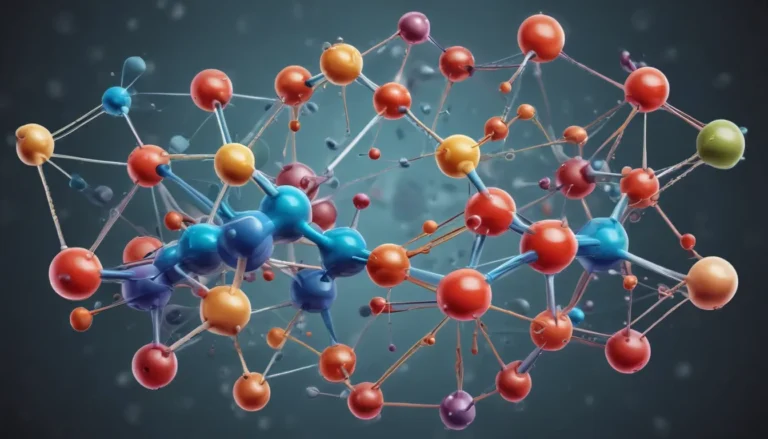A Note About Images: The images used in our articles are for illustration purposes only and may not exactly match the content. They are meant to engage readers, but the text should be relied upon for accurate information.
Are you ready to dive into the captivating world of chelate compounds? These unique chemical entities, formed by the bonding of metal ions with ligand molecules, have intrigued researchers and industries for decades. From their historical significance to their wide-ranging applications in medicine, agriculture, and environmental science, chelates play a vital role in various aspects of our lives. In this article, we will uncover 16 fascinating facts about chelate compounds that showcase their importance and versatility in the realm of chemistry.
Unveiling the World of Chelates
Chelate compounds, derived from the Greek word “chele” meaning claw, refer to complex compounds where a metal ion binds to ligands through multiple coordinating atoms. These ligands, often organic compounds or ions, encapsulate the metal ion in a stable and soluble complex. This unique bonding structure gives chelates a range of applications in chemistry, biology, and industry, making them essential components in numerous chemical processes.
The Marvel of Chelation: Enhancing Metal Stability
One of the most intriguing aspects of chelation is its ability to enhance the stability of metal ions. When metal ions chelate with appropriate ligands, they become more resistant to chemical changes, ensuring their efficacy and usefulness for specific applications. This stability is crucial in preserving the reactivity and availability of metal ions in various chemical and biological processes.
Chelation: A Key Player in Biochemistry
In the realm of biochemistry, chelation plays a vital role in various biological processes. Metal ions such as iron, copper, and zinc form essential complexes with proteins to carry out crucial functions in living organisms. These metalloproteins utilize chelation to create active sites that facilitate enzymatic reactions, ion transport, and metabolic processes, highlighting the significance of chelation in sustaining life.
Unveiling the Applications of Chelation
Chelation finds applications in a myriad of fields, including medicine, agriculture, water treatment, and industrial processes. Let’s explore some of the diverse applications of chelate compounds:
- Chelation in Medicine: Chelation therapy utilizes chelating agents to remove heavy metal toxins from the body, making it a valuable treatment for metal poisoning and related medical conditions.
- Chelation in Agriculture: Chelate compounds are widely used in agriculture to enhance the availability of essential trace elements, promoting plant growth and increasing crop yields.
- Chelation in Water Treatment: Chelating agents play a critical role in water treatment by controlling and removing metal ions to maintain water quality in various industries.
- Chelation in Industrial Processes: Chelate complexes are utilized in industrial processes for metal extraction, purification, and catalysis, showcasing their versatility and efficacy in various applications.
Beyond the Basics: Exploring Chelate Rings and Coordination Polymers
One fascinating aspect of chelation is the formation of chelate rings, where ligands coordinate with a metal ion at multiple binding sites, creating cyclic structures with unique properties. These chelate rings provide additional stability and open doors for the development of new materials with specialized applications. Additionally, coordination polymers, also known as metal-organic frameworks, rely on the chelation process to construct extended architectures used in gas storage, drug delivery, and catalytic systems, further highlighting the versatility of chelates in modern chemistry.
The Role of Chelation in Analytical Chemistry and Photographic Film
Chelation plays a significant role in analytical chemistry, particularly in the precise determination and quantification of metal ions in various samples. By selectively extracting and concentrating specific metal ions, chelating agents enhance the accuracy and reliability of metal analysis in environmental monitoring and quality control processes. Moreover, in the production of photographic film, chelating agents are employed to remove metal impurities and ensure the production of high-quality prints with accurate colors and enhanced longevity.
Exploring Chelation in Environmental Remediation and Cultural Preservation
Chelating agents have shown promise in environmental remediation by assisting in the removal of heavy metals from contaminated sites, minimizing their impact on ecosystems and groundwater. These compounds play a crucial role in immobilizing metal pollutants, reducing their toxicity and environmental harm. Additionally, in the preservation of cultural artifacts, chelation-based treatments help remove metal contaminants and stabilize susceptible components, ensuring the longevity and heritage of historical objects for future generations to appreciate.
Unveiling Natural Chelators and Chelation as a Research Tool
While synthetic chelating agents are widely used, nature also produces its own versions of chelators. Siderophores, small molecules secreted by various organisms, scavenge essential metals from the environment, showcasing nature’s efficient chelation mechanisms. Understanding these natural processes can inspire new strategies in medication, agriculture, and environmental science. Furthermore, chelation serves as a valuable research tool, allowing scientists to study metal interactions and biological processes with precision and control, providing insights into disease mechanisms and enzyme pathways.
A Glimpse into Complexometric Titration: Analyzing Metal Ions with Precision
Alongside chelation, complexometric titration offers a precise method for quantitatively analyzing metal ions in various samples. This analytical chemistry technique provides valuable insights into the concentration and behavior of metal ions, enhancing the accuracy of metal analysis in research, quality control, and environmental monitoring. By understanding the principles and applications of complexometric titration, researchers and analysts can uncover intricate details about metal content in diverse samples, contributing to advancements in analytical chemistry practices worldwide.
Trust in the Power of Knowledge
As we navigate the world of chelate compounds and complexometric titration, it’s essential to trust in the power of knowledge and exploration. Each fact we uncover and each discovery we make contributes to a deeper understanding of the intricate chemical processes that shape our world. By delving into the nuances of chelation, we gain valuable insights into its diverse applications and significance in various scientific disciplines. Let curiosity be your guide as you embark on a journey of discovery and learning, unearthing the hidden gems of chemistry and analytical techniques that enrich our understanding of the world around us.
Conclusion: Embracing the Versatility of Chelates
In conclusion, chelate compounds stand as versatile and essential components in the realm of chemistry, with a myriad of applications across industries and scientific disciplines. From their role in medicine and agriculture to their significance in environmental remediation and cultural preservation, chelates continue to impact various aspects of our lives. By exploring the fascinating world of chelation and complexometric titration, we deepen our understanding of these fundamental chemical processes and their implications for research, industry, and the environment. Let your curiosity and passion for knowledge fuel your exploration of the intricate world of chelate compounds, paving the way for new discoveries and advancements in the field of chemistry.
FAQs: Exploring Common Questions About Chelate
-
What is chelation?
- Chelation refers to the formation of a complex compound where a metal ion is bonded to a ligand through multiple coordinating atoms.
-
How does chelation therapy work?
- Chelation therapy involves using chelating agents to bind to heavy metals in the body, helping to remove them and restore normal cellular function.
-
What are some examples of chelating ligands?
- Common examples of chelating ligands include ethylenediaminetetraacetic acid (EDTA), diethylene triamine pentaacetic acid (DTPA), and 1,10-phenanthroline.
-
What are the applications of chelation in industry?
- Chelation finds applications in various industrial processes, such as metal extraction, catalysis, and stabilization in the production of detergents and cosmetics.
-
Is chelation limited to metal ions only?
- Chelation can also occur between an organic molecule and a metal ion or between two organic molecules, forming a coordination complex with diverse applications.
In conclusion, the versatility and significance of chelate compounds in various fields highlight their importance in shaping modern chemistry and scientific research. Let your exploration of chelation compounds and complexometric titration inspire curiosity and drive towards deeper understanding and knowledge. Embrace the marvels of chelation and analytical techniques as you embark on a journey of discovery and learning in the vast world of chemistry.






